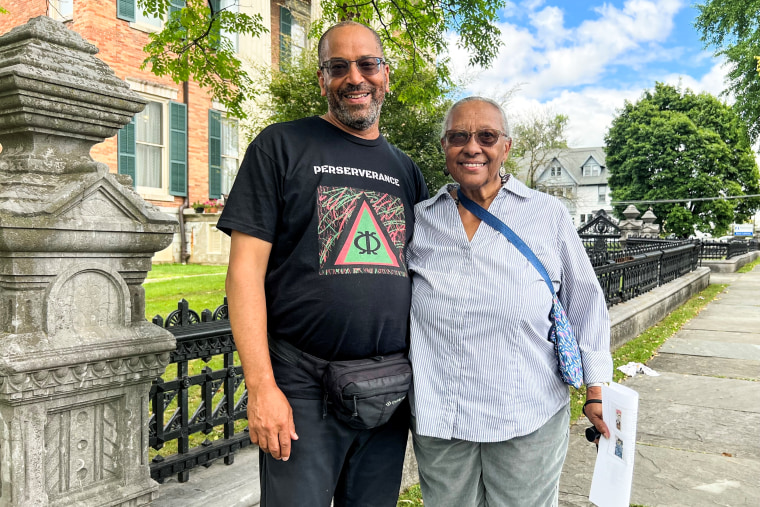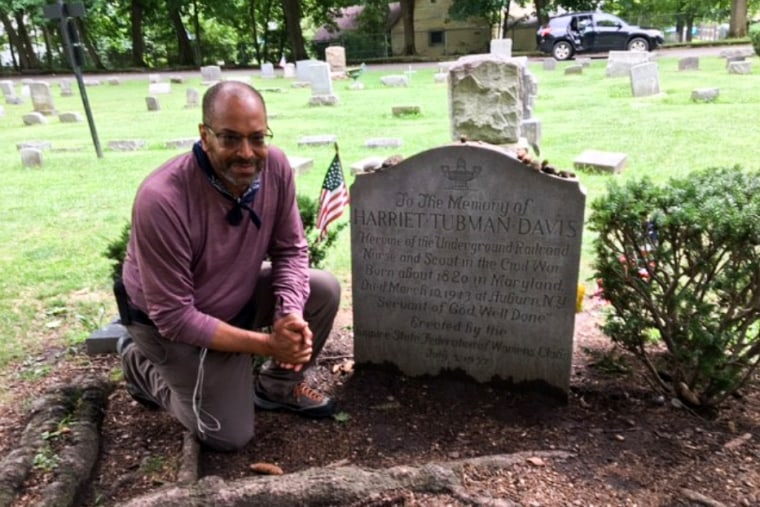Kenneth Johnston of West Philadelphia always had a deep appreciation for Harriet Tubman and her work of freeing enslaved Black people. But instead of reading a book or watching a documentary to remember Tubman’s trek to freedom, Johnston put his shoes on and followed the same path she walked in her honor.
On Saturday, Johnston, 61, completed his over 400-mile trek, which he called a Walk to Freedom. His journey led him across New York state and along the routes of the Underground Railroad, stopping by historic Black sites and communities along the path.
Beginning in July, Johnston’s first stop was the Harriet Tubman Memorial in Harlem, New York. He continued on through the Hudson River Valley, across central New York, and ended his walks at the British Methodist Episcopal Church — the same church Tubman attended in Ontario, Canada.
“I was amazed,” Johnston said of his experience. “It was an incredible journey walking across New York state, particularly from Albany to Buffalo … visiting many of the known Underground Railroad communities.”
This isn’t the first time Johnston performed a Walk to Freedom expedition. In December 2019, Johnston replicated Tubman’s journey to rescue her brothers in 1854 by walking 140 miles along the shores of the Choptank River in Maryland to Philadelphia. Johnston, who completed his 2019 journey in six weeks, said Tubman completed the trek in only four days, “which still blows my mind.”
During his voyage to Canada, Johnston visited historic sites like the Niagara Falls Underground Railroad Heritage Center, where he learned how the free Black community was instrumental in helping to shelter those traveling to Canada in search of freedom. He also stopped by the Cataract House, a hotel that employed many of the enslaved people as waiters. The hotel staff often served as agents for the Underground Railroad.
Aside from the history he learned along the way, Johnston said he felt a spiritual connection in certain places he stopped, like the African burial ground in Kinderhook, New York, where over 500 Black bodies were buried.
“In that place, that’s where you could feel that they were at peace,” he said. In other places, like a Dutch farm in Rotterdam Junction, New York, maintained by the Schenectady County Historical Society, Johnston said he could feel the unsettled spirits of those who were enslaved that still had “a lot of angst in them.”
While Johnston said his journey was deeply meaningful, he admitted it also took a physical toll. On some days he would wake up before dawn to try to beat the sweltering heat, which had days of over 90 degrees. When he became fatigued, he said he would reflect on how enslaved people walked along those difficult paths without an opportunity to recharge or experience some of his modern-day luxuries.
“They didn’t have the special Italian hiking shoes that I have,” Johnston said. “They didn’t have the backpack and all those things that I have. Their journey was more rugged.”
Despite unavoidable challenges during his Walk to Freedom, Johnston said he received a lot of help along the way. He received support from Black and Quaker communities during his journey, with one biracial family even inviting him into their house to stay for the night. He also met Drink Like a Girl! founder Kelly Guilfoyle in Geneva, New York. Johnston said Guilfoyle was so inspired by his commitment to honor those who sought freedom that she helped him find hotels that sponsored his stay for free. Johnston also found help from those online who supported his Walk to Freedom mission. He received over $3,000 in donations for travel expenses from the GoFundMe account he had set up in July.

One of Johnston’s most treasured moments was on Aug. 9 when he traveled through Auburn, New York, meeting Judith Bryant, Tubman’s great-great grandniece. While there, Johnston visited Tubman’s grave.
“It helped me connect to Harriet Tubman even more in her life by meeting her descendants,” Johnston said.

Now that his journey is complete, Johnston said he plans on taking a break before venturing to new paths, including a slave trail stretching over 1,000 miles from Alexandria, Virginia, to New Orleans. He also plans to return to Puerto Rico, which he visited in 2019 following Hurricane Maria, where he walked across the island and spoke with families and artists whose lives were affected by the storm. He also hopes more of these important trails are recognized.
“I would love to see more signage in the promotion of a freedom trail across central and western New York because our story is an American story,” he said. “It was Black and white communities that helped freedom seekers get to Niagara Falls and Buffalo to be able to make that crossing into Canada. It was really an integrated movement in the racial movement.”
